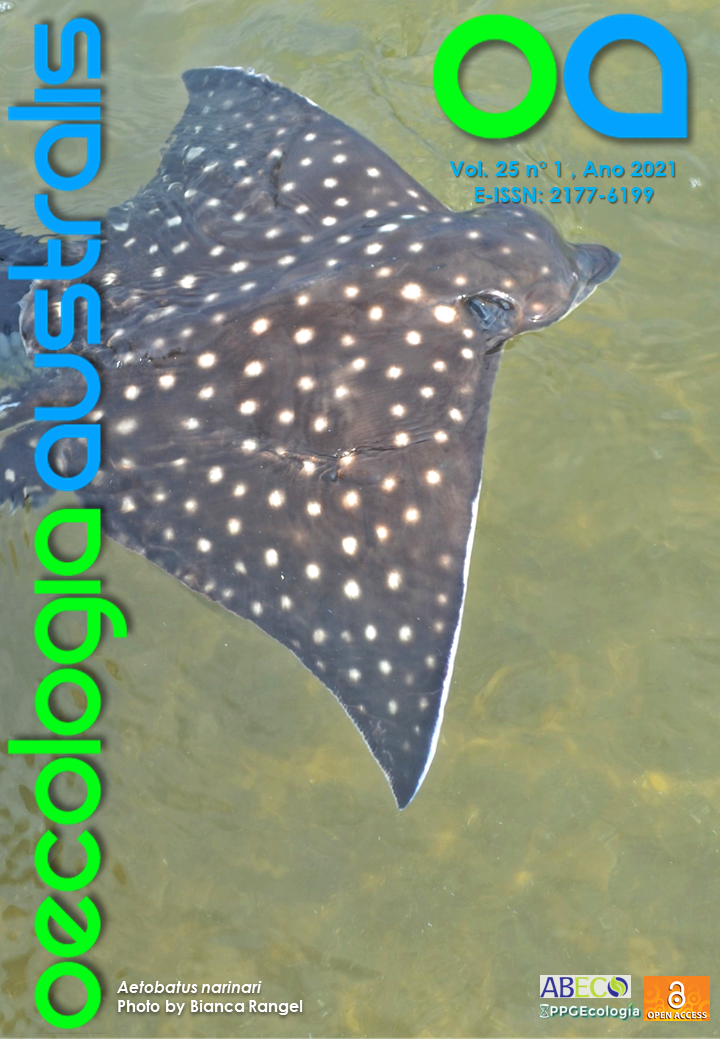MICROCRUSTACEAN ASSEMBLAGES AND WATER QUALITY IN A HIGH-ALTITUDE POND IN SOUTH BRAZIL (PARANÁ)
DOI:
https://doi.org/10.4257/oeco.2021.2501.14Palavras-chave:
Cladocera, Cyclopoida, geographic distribution, limnology, mountain aquatic faunaResumo
The aim of this study was to assess the abundance and richness of microcrustacean, and water physical and chemical characteristics of a high-altitude pond in the Serra do Mar at State of Paraná. Water samples were collected quarterly between August 2015 and August 2016. Environmental conditions of pond were characterized by small pond size and depth, cold and well oxygenated water, and neutral or slightly acid pH. Mean total microcrustacean density was 945.0 ind m-3, whereas total taxon richness was 3.40. The most abundant species was Tropocyclops prasinus. The small size and the isolament of the pond, and the low temperatures were related to the low species richness and abundance. This study is unprecedented to the State of Paraná. Future studies attempt to understand the environmental conditions and distribution of microcrustaceans from high-altitude ponds.
Referências
Barta, B., Mouillet, C., Espinosa, R. Andino, P., Jacobsen, D., & Christoffersen, K. S. 2018. Glacial-fed and páramo lake ecosystems in tropical high Andes, Hydrobiologia, 813, 19–32. DOI: 10.1007/s10750-017-3428-4
Brock, M. A., Nielsen, D. L., Shiel, R. J., Green, J. D., & Langley, J. D. 2003. Drought and aquatic community resilience: the role of eggs and seeds in sediments of temporary wetlands. Freshwater Biology 48, 1207–1218. DOI: 10.1046/j.1365-2427.2003.01083.x
Elmoor-Loureiro, L. M. A. 1997. Manual de identificação de cladóceros límnicos do Brasil. Brasília: Ed. Universa: p. 156.
Eskinazi-Sant’anna, E. M., Freitas, L. D., & Moreira, R. A. 2011. Ecossistemas lacustres montanos: biodiversidade e grau de vulnerabilidade à ação antrópica. MG-Biota, 4, 37–40.
Gyllström, M., & Hansson, L. 2004. Dormancy in freshwater zooplankton: Induction, termination and the importance of benthic-pelagic coupling. Aquatic Sciences, 66, 274–295. DOI:10.1007/s00027-004-0712-y
Muylaert, R. L., Vancine, M. H., Bernardo, R., Oshima, J. E. F., Sobral-Souza, T., Tonetti, V. R., Niebuhr, B. B., Ribeiro, M. C. 2018. Uma nota sobre os limites territoriais da Mata Atlântica. Oecologia Australis, 22(3), 302-311. DOI: 10.4257/oeco.2018.2203.09
IPARDES. 1991. Diagnóstico físico-ambiental da serra do mar – Área Sul. Curitiba: IPARDES. p. 107.
Manca, M., & Armiraglio, M. 2002. Zooplankton of 15 lakes in the Southern central Alps: comparison of recent and past (pre- 1850 AD) communities. Journal of Limnology, 61, 225–231. DOI: 10.4081/jlimnol.2002.225
Martinelli, G. 2007. Mountain biodiversity in Brazil. Revista Brasileira de Botânica, 30, 587–597. DOI: 10.1590/S0100-84042007000400005
Moreira, R. A., Rocha, O., Santos, R. M. Dos, Laudares-Silva, R., Dias, E. S., Moreira, F.W.A., & Eskinazi-Sant’anna, E. M. 2016. Composition, body-size structure and biomass of zooplankton in a high-elevation temporary pond (Minas Gerais, Brazil). Oecologia Australis, 20(2), 219–231. DOI: 10.4257/oeco.2016.2002.06
Perbiche-Neves, G., Boxshall, G. A., Previattelli, D., Nogueira, M. G., & Rocha, C. E. F. 2015. Identification guide to some Diaptomid species (Crustacea, Copepoda, Calanoida, Diaptomidae) of “de la Plata” River Basin (South America). ZooKeys, 497. p. 111. DOI: 10.3897/zookeys.497.8091
Reid, J. L. W. 1985. Chave de identificação e lista de referências bibliográficas para as espécies continentais sul-americanas de vida livre da ordem Cyclopoida (Crustacea, Copepoda). Boletim Zoologia, 9(9)17-147. DOI: 10.11606/issn.2526-3358.bolzoo.1985.122293
Reid, J. W. 1993. Fimbricyclops jimnhensoni, new genus, new species (Copepoda: Cyclopioda: Cyclopidae), from bromeliads in Puerto Rico. Journal of Crustacean Biology, 13, 383–392. DOI: 10.1163/193724093X00156
Ríos-Escalante, P., Hauenstein, E., Acevedo, P., Romero-Miéres, M., & Pandourski, I. 2012. Regulatory factors in crustacean zooplankton assemblages in mountain lakes of northern Chilean Patagonia (38-41 °S): a comparison with Bulgarian counterparts (42 °N). Latin American Journal of Aquatic Research, 40, 473–479. DOI: 10.3856/vol40-issue2-fulltext-24.
Santos-Silva, E. N., Robertson, B. A., Reid, J. L. W., & Hardy, E. R. 1989. Atlas de copépodos planctônicos, Calanoida e Cyclopoida (Crustacea), da Amazônia Brasileira. I. Represa de Curuá-Una, Pará. Revista Brasileira de Zoologia, 6(4), 725–758. DOI: 10.1590/S0101-81751989000400019
Santos–Wisniewski, M. J., Rocha, O., Guntzel, A. M., & Matsumura–Tundisi, T. 2002. Cladocera Chydoridae of high altitude water bodies (Serra da Mantiqueira), in Brazil. Brazilian Journal of Biology, 62 (4a), 681–687. DOI: 10.1590/S1519-69842002000400016
SEMA. 2015. Área de Proteção Ambiental da Serra do Mar. Curitiba: SEMA. Retrieved from http://www.meioambiente.pr.gov.br/modules/conteudo/conteudo.php?conteudo=122. (Accessed in 18/06/2019).
Shiel, R. J. 1995. A guide to the identification of rotifers, cladocerans and copepods from Australian inland waters. Albury, Australia: Co-operative Research Centre for Freshwater Ecology, Murray-Darling Freshwater Research Centre: p. 144.
Smirnov, N. N., & Timms, B. V. 1983. A revision of the Australian Cladocera (Crustacea). Records of the Australian Museum, Supplement. Sydney: Australia: The Australian Museum: p. 132. DOI: 10.3853/j.0812-7387.1.1983.103
Tartarotti, B., Trattner, F., Remias, D., , N., Steinberg, C. E. W., & Sommaruga, R. 2017. Distribution and UV protection strategies of zooplankton in clear and glacier-fed alpine lakes. Scientific reports, 7, 4487. DOI: 10.1038/s41598-017-04836-w
Van Colen, W.R., Mosquera, P., Vanderstukken, M., Goiris, K., Carrasco, M.C., Decaestecker, E., Alonso, M., León Tamariz, F., & Muylaert, K. 2017. Limnology and trophic status of glacial lakes in the tropical Andes (Cajas National Park, Ecuador). Freshwater Biology, 62, 458–473. DOI: 10.1111/fwb.12878


